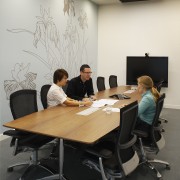Role model
The design of this new bank office underscores a desire to embrace new technologies and ideas, while creating a sustainable workplace model for the future

For any large business, commissioning new offices provides an ideal opportunity to lead by example but it is even more significant when the new premises must create an exemplary workplace that will be a model for the future.
When HSBC looked to fit out its new Singapore office in Mapletree Business City, it wanted a sustainable workplace that would embody the bank's global brand and core values. Anthony Smith, HSBC Singapore vice president corporate real estate and administration, says the fit-out also needed to embrace the HSBC@Work shared workspace programme.
"This programme is all about providing a more flexible, collaborative way of working," he says. "We wanted to move away from the idea of individual ownership of a work space to shared ownership. It's not so much about static work at a single desk as it is about flexible work that can be undertaken in a variety of settings that promote both formal and informal interaction."
Smith says to cater to this new way of working, the office needed to incorporate new technology and applications that would support mobility, including IP telephony, WiFi networks, laptop computers and managed print capabilities. The office also needed to move away from distributed resources to central shared resource areas.
Broadway Malyan design director Ian Simpson says that in response to the brief, his design team developed a concept that was founded in HSBC's identity as The World's Local Bank.
"This allowed the theme of Singapore, the Garden City to be developed as a local reference point that would engage with employees and reinforce a sense of identity by drawing inspiration from the city.
"Much like the fabric of the city, the design of the office centred on providing space that would be flexible, adaptable and permit freedom of movement. The main working floors are therefore standardised as much as possible, in a layout that is not dissimilar to a city grid."

Within the six floors of office accommodation, there are fully flexible cellular spaces for staff, covering 17,000m². Level 2 forms the main entrance and transition from the public and shared space to the HSBC space. Level 9 is the Visitor Hub, which includes the main reception area, visitor meeting rooms, video conferencing facilities, break-out meeting spaces, flexible training studios and a large multipurpose space.
"The Hub, like the heart of a city, forms the core and provides all the central services, such as pantries, vending stations, touchdown areas, formal meeting rooms and storage facilities," says Simpson. "The Hub is surrounded by the primary circulation route, known as The Street. This is bounded by pockets of planting and greenery that form a visual and acoustic barrier between the activity of The Hub and the quieter working space."
Pods along The Street not only serve as wayfinding landmarks, but incorporate service areas, formal and informal meeting spaces and collaboration spaces.
"The pods help break down an expansive floorplate into smaller working communities," says Simpson.
Strong environmental graphics reinforce the theme of Singapore, the Garden City. The design team engaged with HSBC's employees through a photographic competition and the images are featured on personal storage lockers that help foster personal identity within the broader social context of the workplace community.
Meeting rooms are identified by different cities around the world and are complemented by wall graphics of their national flower. For example, the Vanda Miss Joaquim orchid is a backdrop to the Singapore meeting room.
A rigorous approach to the sustainable agenda underpins the design, as requested by the bank.

"HSBC has a long-standing commitment to minimise its impact on the environment," says Smith. "As a bank, we manage risk and identify business opportunities every day, and we seek to embed social and environmental issues in the process. We aim to run a sustainable business for the long term and this project is a perfect example of this a sustainable building being used in a sustainable way. We chose MBC because it is a Green Mark Platinum-rated building."
Typical floors are predominantly open plan to maximise natural daylight penetration and access for all employees. This greatly reduces artificial space cooling and lighting loads. Where mechanical and electrical sources are used, highly energy-efficient products were specified.
Where possible, sustainable materials and furniture were locally sourced, and all materials have a high recycled and low-VOC content. In addition, waste was reduced through retention of base-build walls, doors, ceiling and lighting. Bamboo wood was used as the most sustainable choice for veneer.
"This high-profile project has delivered an exemplary office environment that supports the client's workplace strategy," says Simpson.
The fit-out has also been awarded a Green Mark Platinum rating by Singapore's Building and Construction Authority.
Credit list
Architect
Mechanical and electrical engineer
Fit-out company
Fabric/upholstery
Carpet
Bamboo flooring and veneer
Acoustic ceilings
Paints
Task chairs
Interior designer
Quantity surveyor
Partitioning system
Blinds
Vinyl flooring
Wallcoverings
Laminate
Workstations
Chairs in reception and breakout areas
Story by: Colleen Hawkes
Home kitchen bathroom commercial design
Diving into nature
Classic looks, contemporary efficiency
Personality plus













